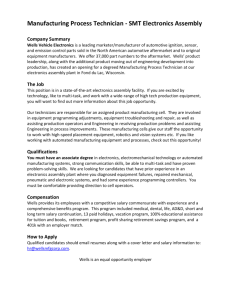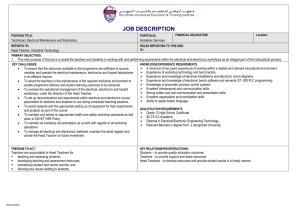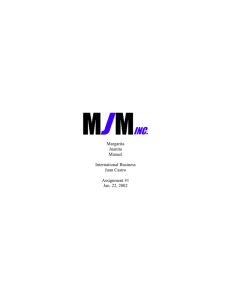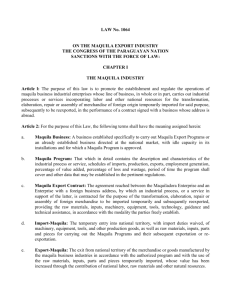Although maquiladoras can only be found in the country of Mexico
advertisement
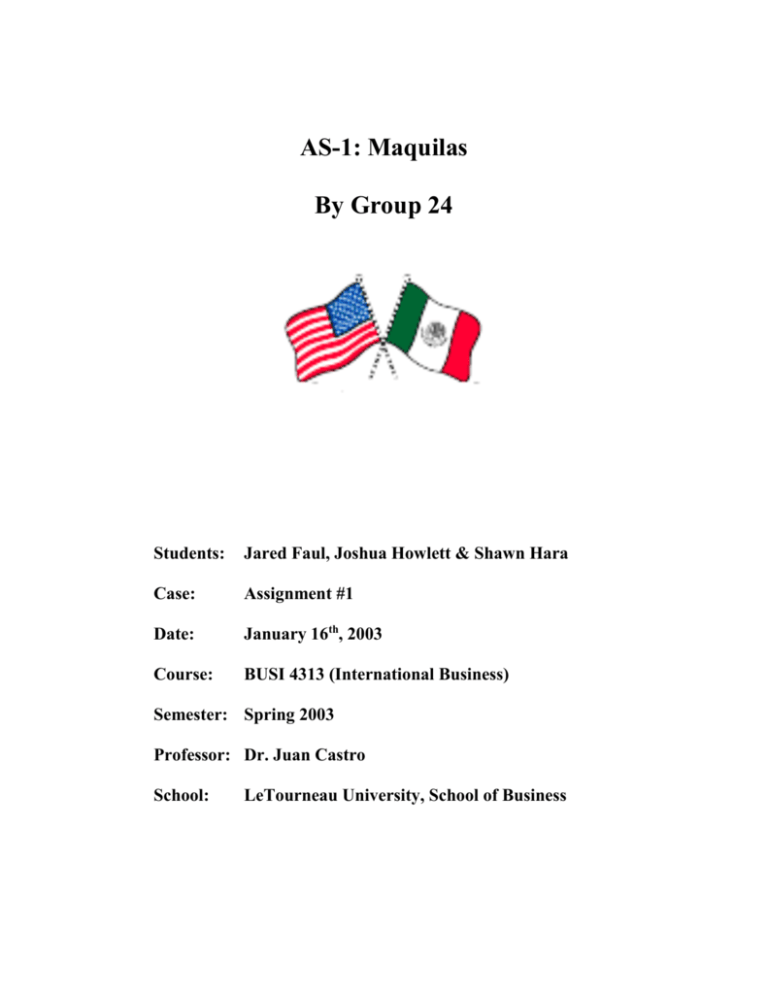
AS-1: Maquilas By Group 24 Students: Jared Faul, Joshua Howlett & Shawn Hara Case: Assignment #1 Date: January 16th, 2003 Course: BUSI 4313 (International Business) Semester: Spring 2003 Professor: Dr. Juan Castro School: LeTourneau University, School of Business Executive Summary (Describe the concept of maquila. Why does it exist? How does it operate?) A maquila, or a maquiladora, is defined as “an assembly plant in Mexico, especially one along the border between the United States and Mexico, to which foreign materials and parts are shipped and from which the finished product is returned to the original market (www.dictionary.com).” Today a maquiladora specifically refers to a plant in Mexico. The first one was established in 1966, and initially they could only be established in the border area (Maquila Portal). Graph 1 Graph 2 The original purpose was to absorb excess labor in the border areas and to encourage Mexican exports in the Baja California Free Trade zone. Over time the concept evolved to where maquilas could be established anywhere in Mexico. They exist almost primarily because of foreign investment. Today they are probably the most important sector of the Mexican economy because of the employment they provide to Mexicans. You can see in Graph 1 that the popularity and number of maquilas had steadily been increasing through the year 2000, with a slight decrease in 2001. In Graph 2 you can see that maquilas benefit Mexico by providing employment opportunities, now providing more than one million jobs. Maquilas also benefit foreign corporate investors by providing goods at a much cheaper cost (Maquila Portal). Situation Analysis (What countries have maquilas, what economic benefits do they receive, and what do these maquilas produce?) Although maquiladoras can only be found in the country of Mexico, ownership of these operations can be found throughout the world, including such countries as the Canada, China, France, Germany, Holland, Japan, Korea, the Netherlands, Italy, Sweden, Spain, Australia, Singapore, Ireland, Finland, England, Malaysia, Columbia, Belgium, and Argentina (Maquiladora). According to some sources, the United States of America directly owns approximately forty percent of the more than 3000 maquilas, while surprisingly, Mexico claims the largest amount of ownership at forty-seven percent. It should be noted, though, that many of these are Mexican-owned subsidiaries of U.S.A. corporations. According to this data, this means that approximately 90% of the maquilas currently in operations can trace their roots to the United States of America (twinplantnews.com). Other sources suggest that the Ownership of Maquilas is divided a little differently, but still places the United States of America as the largest owner [see Graph 3] (Maquiladora). Graph 3 Given this heritage, it is understandable that maquiladoras have had a major impact on the economies of both the U.S.A. and Mexico. U.S.A. corporations were able to find relief from the stringent demands of American unions, resulting in a drop in required labor costs from an average of $21 per hour to $2.51 per hour. In addition, corporations were able to escape strict U.S.A. labor laws and union rules, and were able to fill tedious assembly line jobs that U.S.A. workers were reluctant to take. Furthermore, by moving operations to Mexico, U.S.A. corporations were able to remain competitive with major foreign, especially Asian, competitors offering similar goods and lower prices. “Without the maquila industry, many U.S. companies would have lost the battle against Asian imports and had to close. Instead, shifting production to Mexico allows [U.S.A.] companies to stay competitive and expand in other areas. For example, in the years since NAFTA went into affect, the [U.S.A.] auto industry has actually expanded employment in the [United States of America], while also growing in Mexico (Twin Plant).” Mexico has also greatly benefited from the proliferation of maquiladoras, which have been credited with partially attributing to the growth of the Mexican middle class as well as the recovering of the value of peso after the drastic fall in 1994. Maquilas are now the nation’s second largest source employment with well over one million workers. Graph 4 This massive workforce is involved in a huge variety of different types of manufacturing, with electronic components and appliances as the largest portion at thirty-six percent [see Graph 4]. In fact, ninety-eight percent of all televisions in the United States were made in Mexico. Textiles and apparel, automotive equipment and components, and shelter and medical services also make up a large portion of the manufacturing output of the maquiladoras [see Table 1 in Appendix]. Strategic Alternatives (Are there disadvantages to maquilas? Explain Reverse Maquila.) In determining strategic alternatives to maquilas, it is wise to examine a very new business practice known as Reverse Maquila. The term Reverse Maquila can be applied to two different manufacturing situations:(1) a Mexican firm sets up production on the American side of the border and produces for sale in Mexico, or (2) a Mexican firm establishes production facilities on the American side of the border and sells the output in the United States. Reverse Maquila is exactly what it sounds like. Instead of U.S. firms setting up on the Mexico side of the border, Mexican firms are establishing themselves on the U.S. side of the border. Here are some reasons why these companies go about Reverse Maquila: 1. Many of the American materials used in the manufacturing process are of consistently superior quality to what the firm can obtain in Mexico. 2. There are far fewer problems with organized labor on the American side. 3. Operational services such as electricity and waste disposal are less expensive. 4. NAFTA-level import duties for both nations are becoming progressively lower. 5. Less bureaucracy and less corruption exist on the American side. 6. The finished product does not have to undergo what can be a time-consuming process: passing through U.S. customs. 7. Roads, telecommunications, and waste disposal on American side are far superior. 8. Workers on the American side of the border are better educated and more accustomed to factory work. They are bilingual. 9. Far less housing is available on the Mexican side for the workers, many of whom literally live in cardboard boxes. Because of the poor living conditions, a large number leave after a short time, causing the turnover of the workers to be much higher on the Mexican side of the border. For the same reasons that Mexican companies want to have production operations in the United States, U.S. corporations should thoughtfully consider whether these benefits outweigh the opportunity to have cheap labor in Mexico. Reverse Maquila is a great concept that allows Mexican corporations to have better opportunity. In the U.S. where business is easier to conduct due to better conditions in such areas as communication, transportation, and even waste management, Mexican corporations tend to find greater success provided the conditions for establishment are sound. With less financial pull on the corporation from such things as employee turnover, Reverse Maquila tends to be the correct plan of action for many Mexican corporations and perhaps could shed light on why a U.S. corporation might want to stay right where they are (Ball). Recommended Strategy/Implementation Plan There is no simple answer for whether a U.S. corporation should pursue moving its operations to Mexico in the form of a maquila. Rather, it is important that the company weigh all the factors involved, especially what it is that company desires to produce. Just as Mexican companies have set up shop in the United States of America for the reasons listed in the section on “Strategic Alternatives,” it might be wise for U.S.A. corporations to keep productions in the U.S.A. Obviously though, there can be definite advantages to choosing the maquila, most notably cheaper labor and the lack of confining regulations. Especially if the production involves very tedious, repetitive labor, maquilas seem to be the best option. In order to implement a strategy to produce in maquilas, much work would have to be done to thoroughly understand the laws and guiding structures of the maquila systems, trade laws, the culture of Mexico, as well as the ethical aspects of the sometimes “sweatshop-style” working conditions of the maquilas. Bibliography: Ball, Don, and Wendell McCulloch. International Business. 7th ed. Boston: Irwin/McGraw-Hill, 1999. 45-80. Brouthers, Lance E. Maquiladoras: entrepreneurial experimentation to global competitiveness. Mar. 1999. Business Horizons. 15 Jan. 2003 <http://www.findarticles.com/cf_0/m1038/2_42/54370814/p1/article.jhtml?term=maquila>. Maquiladora History and Statistics. SOLUNET: Info-Mex., Inc. 15 Jan. 2003 <(http://www.solunetinfomex.com/faqs.html)>. Maquila Portal. 12 Jan. 2003 <http://www.maquilaportal.com>. Twin Plant. 15 Jan. 2003 <http://www.twinplantnews.com> Appendix Table 1 Updated on 10-16-2002 RANK 2002 COMPANY EMPLOYEES 1 DELPHI AUTOMOTIVE SYSTEMS 39478 2 YAZAKI CORPORATION 14572 3 OFFSHORE INTERNATIONAL 11615 THOMSON CONSUMER ELECTRONICS 4 (RCA) 10874 5 FORD MOTOR COMPANY 10024 6 SONY CORPORATION OF AMERICA 9679 7 KEMET CORPORATION 9200 8 LEAR CORPORATION 8569 9 ALCOA FUJIKURA LTD 7650 10 TYCO INTERNATIONAL LTD 6785 11 A.O. SMITH CORPORATION 6598 12 CAROLINA COUPON CLEARING INC 6542 13 SANMINA-SCI 6300 14 GENERAL ELECTRIC COMPANY 5965 15 SANYO NORTH AMERICA GROUP 5879 16 SAMSUNG TIJUANA PARK 5789 17 BREED TECHNOLOGIES, INC 5687 18 EMERSON ELECTRIC CO. 5678 19 AMERICAN INDUSTRIES 5332 MATSUSHITA ELECTRIC CORP. OF 20 AMERICA 4986 21 SUMITOMO WIRING ELECTRIC SYSTEMS 4879 22 DAEWOO INDUSTRIAL CO., LTD 4856 GENERAL INSTRUMENTS 23 CORPORATION 4589 24 SEAGATE TECHNOLOGY INC 4582 25 JOHNSON AND JOHNSON COMPANY 4569 26 TRW INCORPORATION 4554 27 PHILIPS ELECTRONICS 4387 28 ALLEGIANCE CORPORATION 4289 29 COLLECTRON OF ARIZONA, INC. 4256 30 ATTEL DEL NORTE S.A DE C.V 4238 31 ITT INDUSTRIES 3845 32 HITACHI HOME ELECTRONICS 3700 33 JOHNSON CONTROLS, INC 3589 34 LEVITON MANUFACTURING COMPANY 3256 35 QUIRK WIRE CO. 3120 36 SCIENTIFIC ATLANTA INCORPORATION 2996 37 STRATTEC SECURITY CORPORATION 2879 38 AVERY DENNISON 2830 INTERNATIONAL BUSINESS MACHINES 39 (IBM) 2689 40 INTERMEX MANUFACTURA 2600 41 LEVI STRAUSS & CO. 2598 42 NOVA LINK 2591 43 ALLIED SIGNAL CO. 2589 44 AVX CORPORATION 2587 45 MATTEL INC. 2578 46 HONEYWELL INCORPORATION 2489 NO. PLANTS IN COUNTRY OF MEXICO ORIGIN 28 USA 12 JAPAN 1 MEXICO 6 USA 7 USA 4 JAPAN 8 USA 8 USA 8 JAPAN 4 USA 8 USA 5 USA 7 USA 7 USA 2 JAPAN 3 KOREA 9 USA 7 USA 22 MEXICO INDUSTRIAL SECTOR AUTOMOTIVE AUTOMOTIVE SHELTER SERVICES ELECTRONICS AUTOMOTIVE ELECTRONICS ELECTRONICS AUTOMOTIVE AUTOMOTIVE ELECTRONICS,MEDICAL ELECTRICAL SERVICES ELECTRONICS ELECTRICAL ELECTRONICS ELECTRONICS AUTOMOTIVE ELECTRICAL SHELTER SERVICES 4 JAPAN 6 JAPAN 3 KOREA ELECTRONICS ELECTRICAL ELECTRONICS 3 USA 4 USA 5 USA 5 USA 8 NETHERLANDS 5 USA 3 USA 1 USA 4 USA 3 JAPAN 7 USA 4 USA 2 USA 1 USA 1 USA 2 USA ELECTRONICS ELECTRONICS MEDICAL AUTOMOTIVE ELECTRONICS MEDICAL SERVICES ELECTRONICS AUTOMOTIVE ELECTRONICS AUTOMOTIVE ELECTRICAL ELECTRONICS ELECTRONICS AUTOMOTIVE OFFICE PRODUCTS 1 USA 9 MEXICO 2 USA 2 USA 4 USA 2 USA 1 USA 3 USA ELECTRONICS SERVICES APPAREL TEXTILE AUTOMOTIVE ELECTRONICS TOYS ELECTRONICS 47 48 49 50 51 OPTEK-DANULAT INC ADVANCE TRANSFORMER CO. HAMILTON PROCTOR-SILEX, INC YALE DE MEXICO, S.A DE C.V AVENT PHELPS DODGE MAGNET WIRE 52 COMPANY 53 EATON CORPORATION 54 ACCO BRANDS INC. 55 PLAMEX S.A. DE C.V. 56 SIEMENS ENERGY & AUTO INC. 57 BOSE CORPORATION 58 SKYWORK SOLUTIONS 59 ACUSTAR INCORPORATION 60 NATIONAL PROCESSING COMPANY 61 EDM INTERNATIONAL 62 CALIFORNIA CONNECTION, INC. 63 COASTCAST CORPORATION 64 AM-MEX PRODUCTS, CO. 65 DATAMARK, INC. SUNBEAM-OSTER HOUSEHOLD 66 PRODUCTS 67 HUBBEL INCORPORATED 68 GREEN GIANT PILLSBURY, CO. 69 KEYTRONICS CORPORATION 70 SCHLAGE DE MÉXICO S.A. DE C.V. 71 CARLINGSWITCH, INC. 72 SUN APPAREL, INC. 73 INTERNATIONAL RECTIFIER CORP. 74 R.G. BARRY CORPORATION 75 SAMSONITE INCORPORATION 76 IRVIN INDUSTRIES, INC. 77 DOUGLAS FURNITURE, INC 78 BLUEBERRY CONFECTIONS INC. 79 THE CHAMBERLAIN MFG 80 MEX MILL, CO. 81 NCH PROMOTIONAL SERVICES MINIATURE PRECISION COMPONENTS, 82 INC. 83 ANCHOR FOOD PRODUCTS, INC 84 COILCRAFT, INC. 85 COOPER-STANDARD AUTOMOTIVE 86 OHAVE INTERNATIONAL CENTER ALPINE ELECTRONICS OF AMERICA, 87 INC. 88 SARA LEE CORPORATION 89 BRAS ELECTRONICS 90 RASSINI INTERNATIONAL, INC. 91 SEATT CORPORATION 92 ACCURIDE INTERNATIONAL 93 ELAMEX DE JUAREZ S.A DE C.V. 94 MOTOROLA INCORPORATION 95 MCCULLOCH, CO. 96 FRUIT OF THE LOOM COMPANY 97 NOMA APPLIANCE ELECTRONIC 98 HASE LEMAMMARZ INTERNATIONAL 99 BORDER APPAREL LAUNDRY INC. 100 REGAL PLASTICS 2488 2387 2331 2169 2150 2 GERMANY 3 USA/HOLLAND 3 USA 1 USA 2 USA MEDICAL ELECTRONICS APPLIANCES APPAREL MEDICAL 2136 2113 2063 2060 2056 2050 2035 2003 1961 1948 1904 1886 1879 1865 1 USA 2 USA 2 USA 1 USA 2 GERMANY 2 USA 1 USA 1 MEXICO 2 USA 2 USA 2 USA 1 USA 3 USA 2 USA ELECTRICAL AUTOMOTIVE STATIONARY TECHNOLOGY AUTOMOTIVE ELECTRONICS SEMICONDUCTORS AUTOMOTIVE SERVICES SERVICES APPAREL SPORTING GOODS SERVICES ELECTRONICS 1853 1850 1844 1806 1789 1760 1752 1705 1689 1652 1633 1613 1596 1589 1587 1569 2 USA 4 USA 1 USA 1 USA 1 USA 2 USA 4 MEXICO 1 USA 3 USA 1 USA 2 USA 1 USA 2 USA 1 USA 1 USA 3 USA ELECTRONICS ELECTRONICS FOOD PROCESSING ELECTRONICS SECURITY ELECTRICAL APPAREL ELECTRONICS APPAREL ACCESORIES AUTOMOTIVE WOODEN FURNITURE FOOD PROCESSING ELECTRICAL AIRCRAFT SERVICES 1565 1549 1547 1520 1508 2 USA 1 USA 2 USA 3 USA 1 CHINA AUTOMOTIVE FOOD PROCESSING ELECTRONICS AUTOMOTIVE ELECTRONICS 1502 1489 1475 1456 1420 1355 1268 1258 1257 1256 1235 1110 1056 1023 1 JAPAN 2 USA 1 USA 1 USA 1 USA 2 USA 18 USA 2 USA 1 USA 2 USA 2 CANADA 1 USA 1 USA 1 USA AUTOMOTIVE APPAREL ELECTRONICS METAL ELECTRONICS STEEL PRODUCTS SERVICES ELECTRONICS ELECTRONICS APPAREL AUTOMOTIVE AUTOMOTIVE APPAREL PLASTICS Due to the number of sources from which the contents is obtained, Maquila portal does not warrant the accuracy or completeness of this list.




